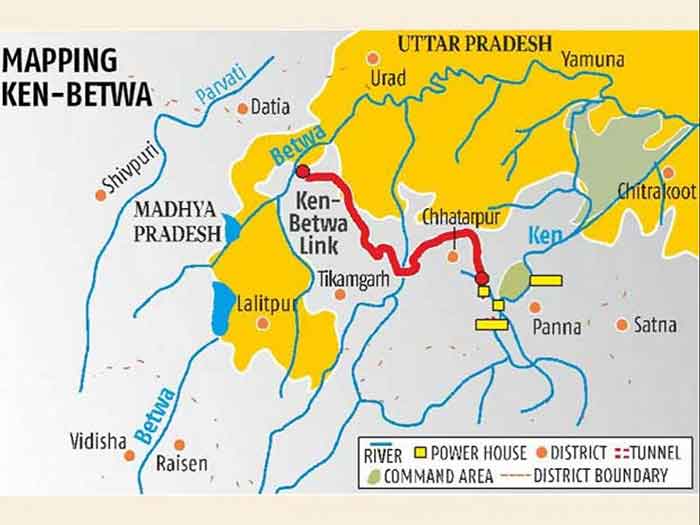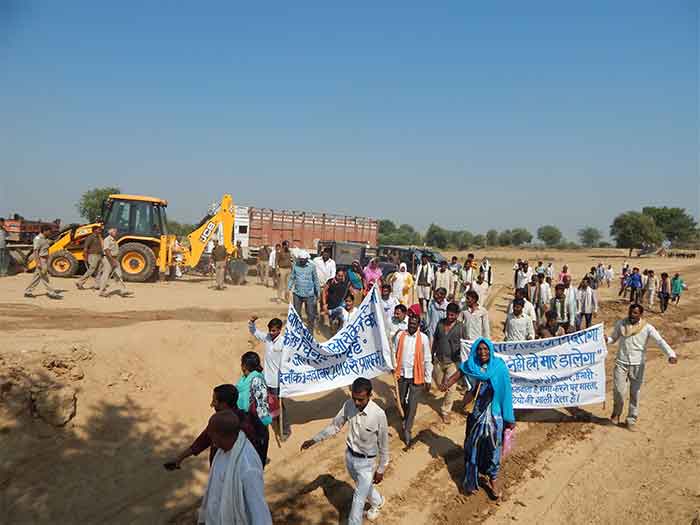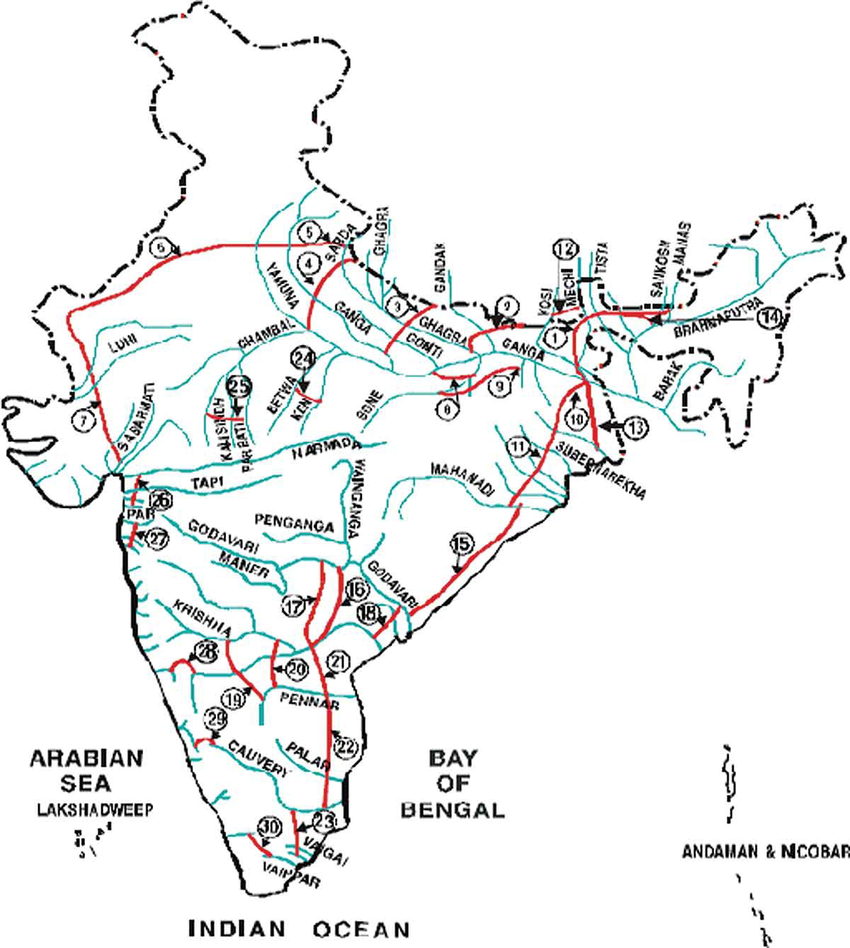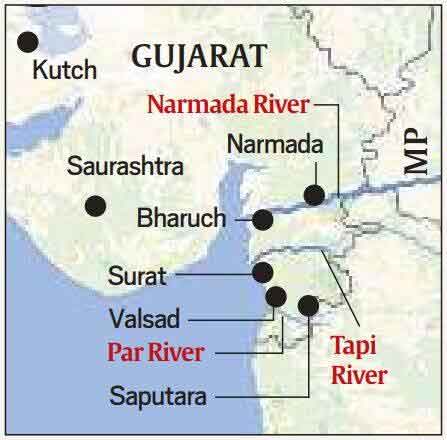
For a long time a gigantic and recklessly ambitious project proposed in India for linking about 37 rivers at 30 or more places had been largely dormant. Things started moving in its favor after the 2014 elections and the installation of the NDA government. Within about two years this project had been pushed ahead quite a bit.Now with the Cabinet approval being granted to the first sub-project of the wider national project called Ken-Betwa Link Project (KBLP) in Central India on December 8 2021( although some clearances are still to be obtained), the wider project also appears to have gathered pace. If the costly, Rs. 45000 crore KBLP with so many objections and inherent problems could be cleared, the argument goes, then what stands in the way of go-ahead being obtained for some or even all of the 30 or more sub-projects of the highly controversial Indian River Link Project (IRLP).
In these times of climate change, it appears inconceivable that any project that starts with the felling of a million trees would even be taken up for consideration. In the case of KBLP a figure of over 2 million trees likely to be felled was provided by the sub-committee of the forest advisory committee several yers back. It was also stated at that time that by the time of implementation the number of threatened trees would be much more. A more realistic figure now would be closer to 3 million threatened trees. If this many trees are going to be felled for a dam and canal project to transfer water from Ken river to Betwa river, then this single fact of the loss of so many trees should be considred adequate in itself to end all further discussion on the project.
But it so happens that in the present case there is no evidence even of surplus water being available in te Ken river for transfer to the other river. The Ken and Betwa river basins are neighboring basins, experiencing similar weather conditions, flood or drought, at the same time, so in any case the entire plan of transferring water from surplus to deficit area makes little sense. The project is supposed to help Bundelkhand region , but there are many reports and studies on this region which say its problems can be solved at lesser cost and without ecological disruption in other ways, using many low-budget, small water conservation, rain harvetng initiatives. Due to reckless sand mining, the Ken river and its tributaries have been badly ravaged. This river sytem needs protection, not transfer of its water..
While alll these objections have been repeatedly voiced by local people and several eminent experts, these have not come in the way of the government giving apropval to KBLP. This is why there is growing concern about the possibilities of much bigger, in fact colossal disruption from IRLP becoming a real possibility. The most worrying aspect of the IRLP is precisely that all the adverse opinions as well as concerns about disruptive impacts voiced by many well-informed and senior persons, including those who have occupied senior positions in the government in water, environment and related areas, have not led to the need for greater caution on the part of the Union government. .
The press release by the Press Information Bureau and Jal Shakti Minstry on December 8 on the approval of KBLP stated—This project will pave the way for more interlinking of river projects in India. On 31 December another release on KBLP stated—This agreement heralds the beginning of inter-state cooperation to implement the vision of Sh. Atal Bihari Vajpayee to carry water from areas that are surplus to drought prone and water deficit areas,through the interlinking of rivers. Hence it is clear that the union government is seeing the KBLP as merely the first of many river-linking projects.
The IRLP involves the linking of around 37 or so rivers by creating a vast network of dams and estimated 15000 km. canals. These figures give us an approximate idea of the magnitude of the project, but this is by no means final and settled as this is still a project in making. Even the first sub-project KBLP has undergne some changes in the course of time.
The authorities claim that IRLP will increase irrigation and domestic water supply significantly, while also making substantial additions to hydel power generation. In fact huge additions of 34 gigawatts of electricity and 34 million hectares of irrigation have been promised at official level. These figures were cited by former Union Water Resources and River Development Minister Uma Bharti in an interview with Sandeep Unnithan of India Today in 2016 ( See– We are creating 31 new rivers, India Today, April 18, 2016). In this interview the Minister also said that the gigantic project’s cost has now gone up to Rs. 11 lakh crore. ( ten lakh=one million, one crore=10 million). To raise the money she said we’ll see how we can commercialise irrigation, try the PPP mode, or get the private sector involved.
On the time-frame the Minister said that the first project of Ken-Betwa link will be completed in seven years. This and three other projects the Daman Ganga-Pinjal, the Partapi Narmada project and the Chambal-Kalsind will all be completed in seven years to be followed by others like Mahanadi, while all will be completed in 20 years. She said, “ I can say with certainty that we can complete these projects in maximum 20 years.” In addition, the minister said, “ I have spoken with surface transport minister Nitin Gadkari and asked him to include the 31 inter-link river canals in the list of 101 inland waterways he is working on.”
If all this actually happens, then this will be the biggest ever human-made changing of the geography and ecology of rivers in India to be carried out within such a narrow time span of two decades. If this project was estimated at Rs. 11 lakh crore in 2016 one can imagine what its final cost will be given the cost escalations normally associated with such projects.
What about the social and environmental costs? The issue of people displaced by dams and canals has always been a troubling one in a densely populated country like India. Significantly the government authorities do not appear to have reliable information on this. In the interview quoted above when the minister was asked about the project affected people she said, “we are unable to calculate the numbers now, but don’t look at the project-affected people, look at the benefits of this project.” A figure of about 15 lakh people likely to be displaced and about one lakh hectare of forest likely to be submerged has often been mentioned as a rough and ready calculation, but this is likely to be an underestimate if we are careful to include all the indirect impacts as well.
Finding all the impacts and implicarions in a reliable way for such a gigantic programme involving the construction of innumerable dams and related structures and many thousands of kms. of canals will be a complex exercise which will require a lot of expertise and time which may not be available if things are done in a rush.
At present reliable estimates of deficits and surpluses are not available yet in most cases and hence the entire basis of the project is questionable from this point of view. In the intrview quoted above the Minister said that no state admits ir has surplus water so we have ordered studies. She said, describing the situation of her tenure as minister in 2016, “ We are doing an MOU with the European Union and Australia who have done such work on the Danube and Murray Darling.”
There is a very clear need to make a distinction between the natural confluence of rivers and the forced human made linkages such as the ones being attempted in this project. The natural confluences of various rivers evolved over thousands or even lakhs of years in keeping with the overall geographic and topographical situations. The biodiversity of the river and nearby areas was thus well adjusted to this. However changing natural river flows for forced linkages are different and can play havoc with the bio-diversity of both rivers. Due to changed river paths and diversions, water availability including water recharge over vast areas can be adversely affected. Rivers may show resistance to the forced change in paths, in which case more destructive floods may be unleashed. Water flow may have to be lifted across divergence path requiring vast energy sources.
Hence some basic aspects of this very costly project are so questionable that it can easily land us in a terrible mess. Hence it is very important to initiate a wide and well-informed debate on this gigantic project at an early stage to prevent the emergence of an unprecedented ecological havoc, that too in times of climate change.
Bharat Dogra is Honorary Convener, Campaign to Save Earth Now. His recent books include Planet in Peril, Protecting Earth for Children and Man Over Machine.













































